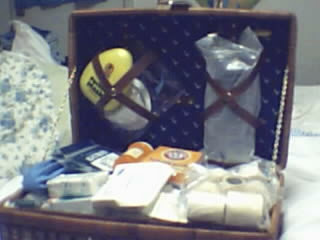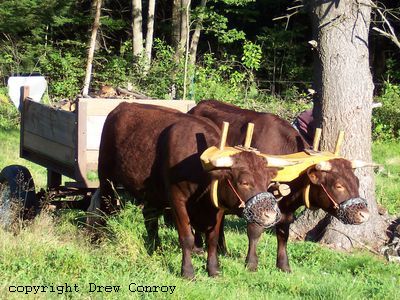
I have seen folks who have had first aid kits consisted of little more than a box of bandaids and a tube of neosporin. I have seen others that would qualify as a small hospital.
Mine lies somewhere in the middle.
A First Aid Kit (FAK) need not *break the bank*. You can add to it slowly and gradually, similar to your other emergency supplies.
Here are the contents of a basic FAK, I have all this PLUS more items I will not list here.
First Aid Kit Contents
3 drawstring trash bags
5 quart sized ziplock freezer bags
1 box baking soda (unopened, sealed in ziplock bag)
1 bottle white vinegar
1 bottle hydrogen peroxide
1 bottle rubbing alcohol
1 Epi-pen (Dr.'s Rx. Used for immediate treatment of allergic reactions)
1 bottle hydrocodone (Vicoden) 30 pills (Dr.s Rx, strong pain reliever)
1 large bottle aspirin
1 large bottle non-aspirin pain reliever (Tylenol, or store brand)
1 tube Icy-Hot
1 box Benadryl Allergy
1 box Benadryl Cold and Sinus
1 box Tylenol PM
1 box Ex-Lax
1 box Imodium (for diarrhea)
1 tube neosporin
1 tube Benadryl cream
1 bottle iodine
2 bottles Calomine lotion
1 bottle Lubriderm medicated lotion
1 bottle aloe-vera gel for sunburn
1 bottle Poison Ivy extract (homeopathic remedy)
1 bottle Visine
1 bottle Clear eyes
1 bottle Lice shampoo
1 tube Ora-gel
1 bottle Oil of Cloves
1 tube anti-fungal cream
1 hot water bottle
1 ice pack bottle
1 pack air filter masks
4 rolls surgical tape
4 rolls cloth tape
2 large rolls gauze bandage
10 gauze pads (large)
10 gauze pads (med.)
10 gauze pads (small)
Large bag of assorted sized Bandaids (approx. 300)
1 bar soap
2 small packs tissue
1 rectal thermometer
1 oral thermometer
3 pairs of tweezers
1 pocket mask (for administrating mouth to mouth)
1 bag cotton balls
10 adhesive removal pads
25 alcohol pads
1 candle
1 lighter
1 pack of matches (in ziplock w/lighter and candle)
1 EENT light (you know, the little light the doc uses to look in your ears and nose, etc.)
Lets do this by sections:
First:
3 drawstring trash bags
5 quart sized ziplock freezer bags
1 box baking soda (unopened, sealed in ziplock bag)
1 bottle white vinegar
You probably have all those items already. The trash bags are good for myriad purposes. Improvised rain poncho, ice pack, to bind up a wound, dispose of contaminated bandages, etc.
The Ziplock bags can be used for disposal of biological wastes, to take a urine or stool sample to a doctor, to put a severed finger or toe in until you can get to the doctor, to put a knocked out tooth in (with a bit of milk) so you can rush to the dentist (Believe it or not, if that is done and you can get to the dentist within an hour, they may be able to re-implant your tooth!), you can also use the bags to make a hot water bottle or an ice pack, to blend ingredients for a poultice, etc.
Baking soda can be used for bathing to lessen the itching of various rashes and conditions, mixed with a bit of water into a paste to put on a bee-sting, a spoonful in a glass of water will relieve heartburn or to add salt back into the system if severely dehydrated.
Vinegar takes the *burn* out of sunburn, can be used to wash wounds, will lessen diarhhea whe you add a couple spoonfuls to a glass of water, will detach leeches and some other *clingy* vermin such as chiggers.
1 bottle hydrogen peroxide
1 bottle rubbing alcohol
These two items should be in EVERY FAK.
Peroxide will wash out wounds, sterilize (to an extent) tweezers, needles, etc.
Alcohol, again--wound treatment, sterilization of implements, rub downs to bring down fevers, etc.
1 Epi-pen (Dr.'s Rx. Used for immediate treatment of allergic reactions)
1 bottle hydrocodone (Vicoden) 30 pills (Dr.s Rx, strong pain reliever)
These two items can only be obtained with a Doctors prescription.
DO NOT GET EITHER IF YOU OR A HOUSHOLD MEMBER HAS A HISTORY OF SUBSTANCE ABUSE!
I have the Epi-Pen as a few members of my family are allergic to bee stings. If I do not use it within a years time, I take the unused unit back to my doctor and obtain a new prescription. DO NOT RELY ON OUT-OF-DATE MEDICATIONS! They can and will kill you in an emergency situation.
Same for the hydrocodone. I have exactly 30 pills. In the bottle is a piece of paper and a small pen is attached to the bottle. If I need to take this medication (or anyone else in my household), I write down the day, time and reason. Again, at the end of one year, I take the bottle back to my doctor and get a new prescription.
1 large bottle aspirin
1 large bottle non-aspirin pain reliever (Tylenol, or store brand)
1 tube Icy-Hot
1 box Benadryl Allergy
1 box Benadryl Cold and Sinus
1 box Tylenol PM
1 box Ex-Lax
1 box Imodium (for diarrhea)
1 tube neosporin
1 tube Benadryl cream
1 bottle iodine
1 bottle Visine
1 bottle Clear eyes
1 bottle Lice shampoo
1 tube Ora-gel
1 bottle Oil of Cloves
1 tube anti-fungal cream
2 bottles Calomine lotion
1 bottle Lubriderm medicated lotion
1 bottle aloe-vera gel for sunburn
1 bottle Poison Ivy extract (homeopathic remedy)
Here's where it gets pricey! All of these are OTC (over the counter, available without a prescription) Some (such as the aloe-vera gel) need to be rotated pretty regularly (every 6 months to a year). But if you buy only one of item each week or every two weeks, it isn't so bad on the wallet.
The items are self-explanatory. In an emergency situation, especially a SHTF one, all could be quite useful for the normal day-to-day ills of your household.
1 hot water bottle
1 ice pack bottle
1 pack air filter masks
4 rolls surgical tape
4 rolls cloth tape
2 large rolls gauze bandage
10 gauze pads (large)
10 gauze pads (med.)
10 gauze pads (small)
Large bag of assorted sized Bandaids (approx. 300)
1 bar soap
2 small packs tissue
1 rectal thermometer
1 oral thermometer
3 pairs of tweezers
1 pocket mask (for administrating mouth to mouth)
1 bag cotton balls
10 adhesive removal pads
25 alcohol pads
1 candle
1 lighter
1 pack of matches (in ziplock w/lighter and candle)
1 EENT light (you know, the little light the doc uses to look in your ears and nose, etc.)
Some of this stuff is pricey, some not so much.
Most of this is for physical repairs, removing splinters, dressing wounds, etc.
Again, one item bought at regular intervals and added to your FAK is a great way to spread out the cost.
I keep my primary FAK in a large woven picnic basket.
You may want to use a small suitcase or a gym bag. Whatever works for you is fine. Try to keep it as organized as possible and always remember to keep a pad of paper and a pen or pencil.
Here's mine, all packed and ready to go...


